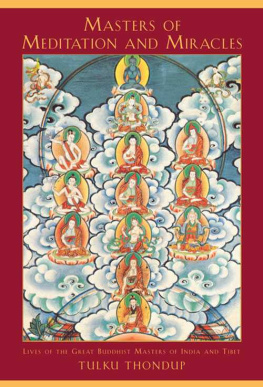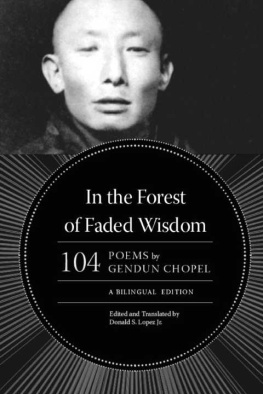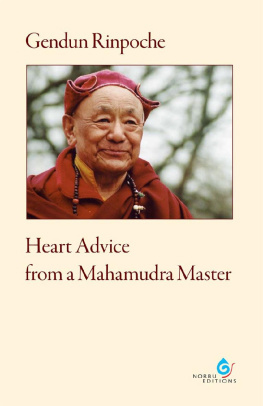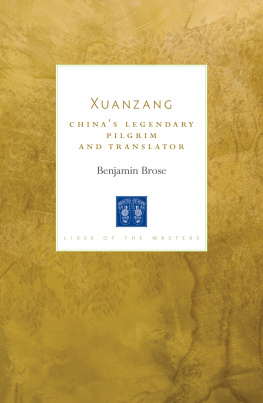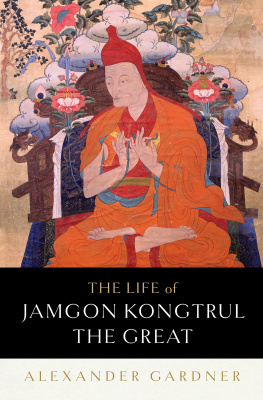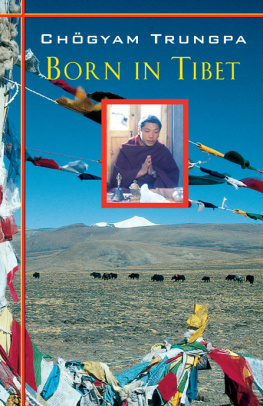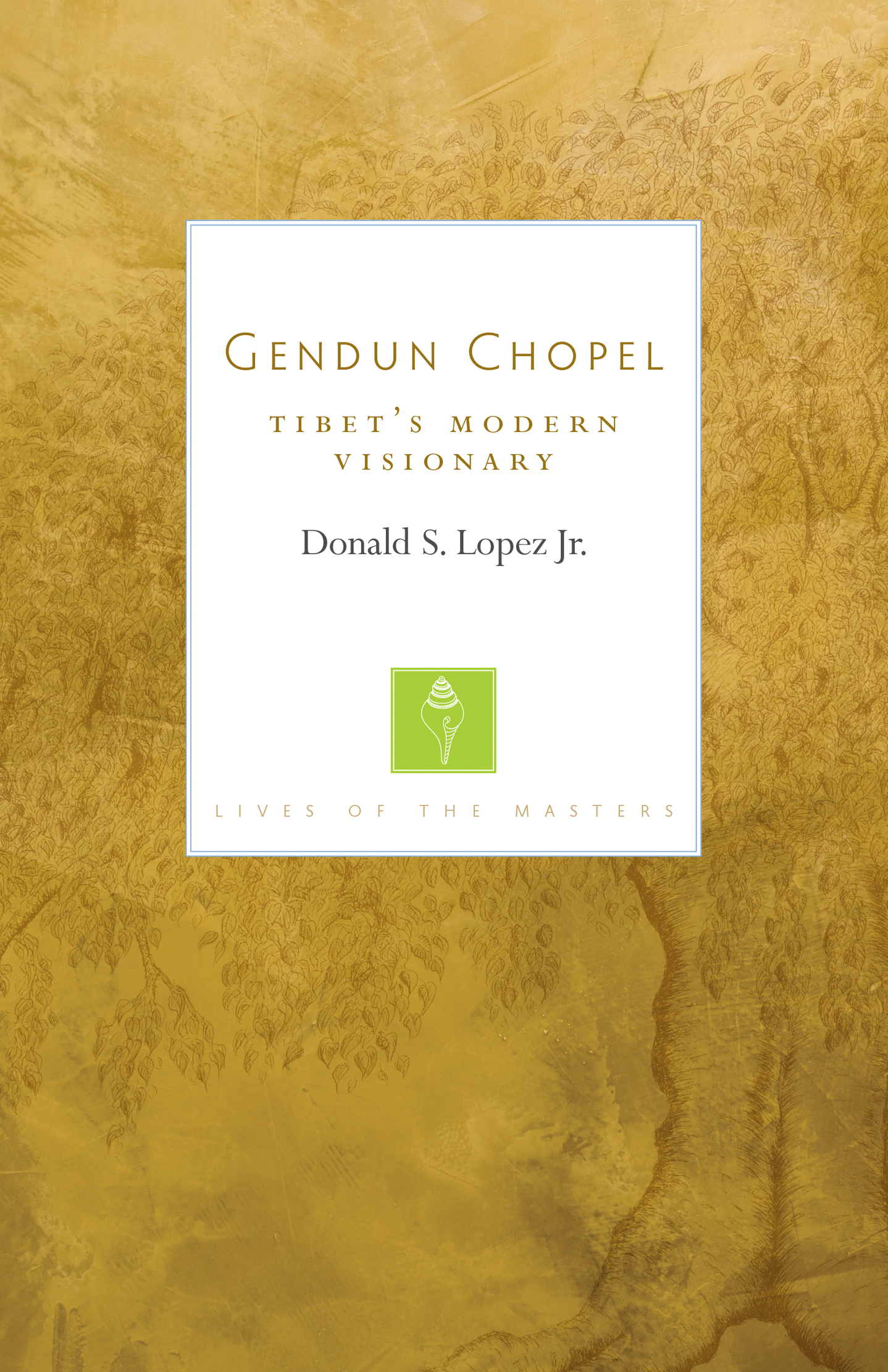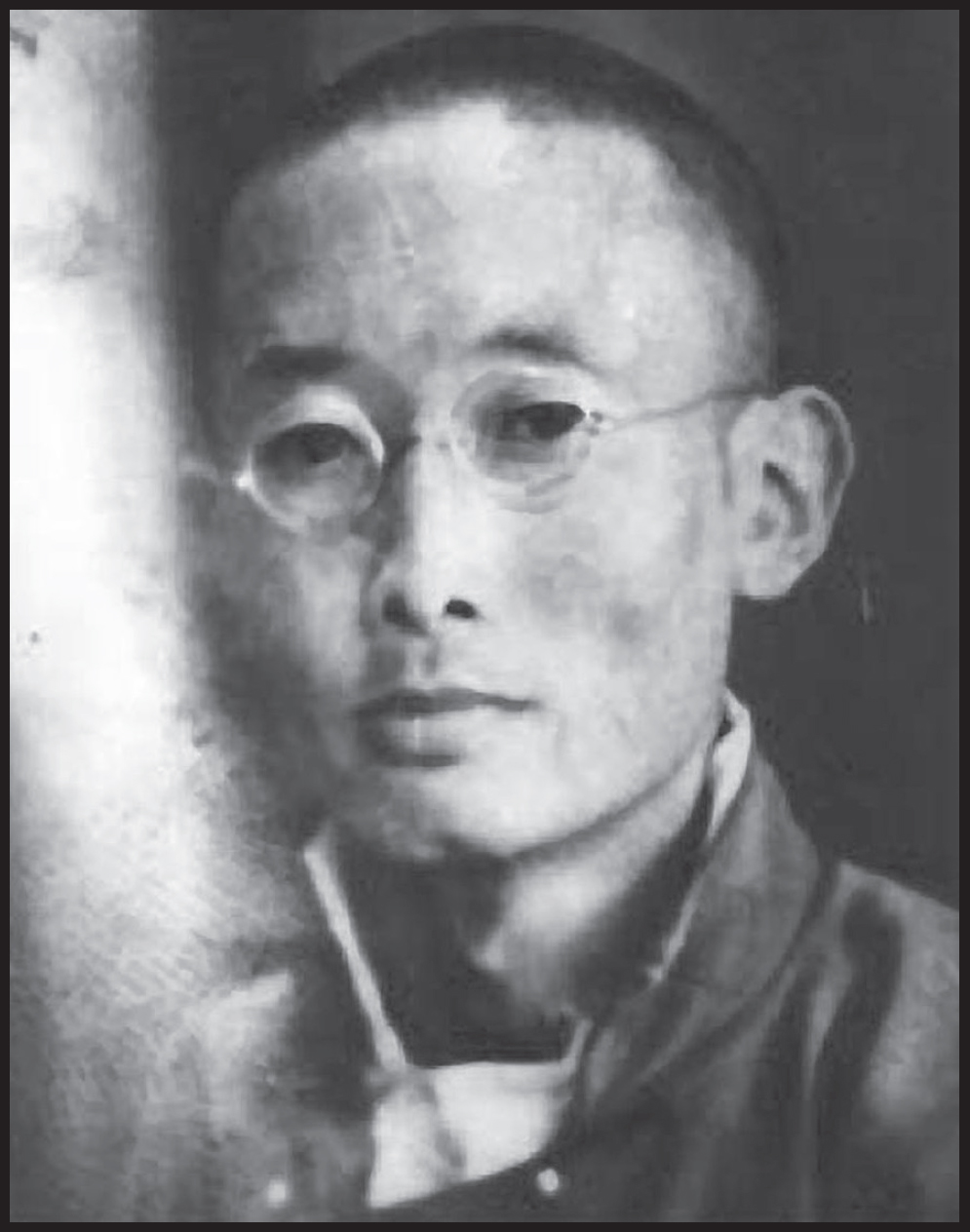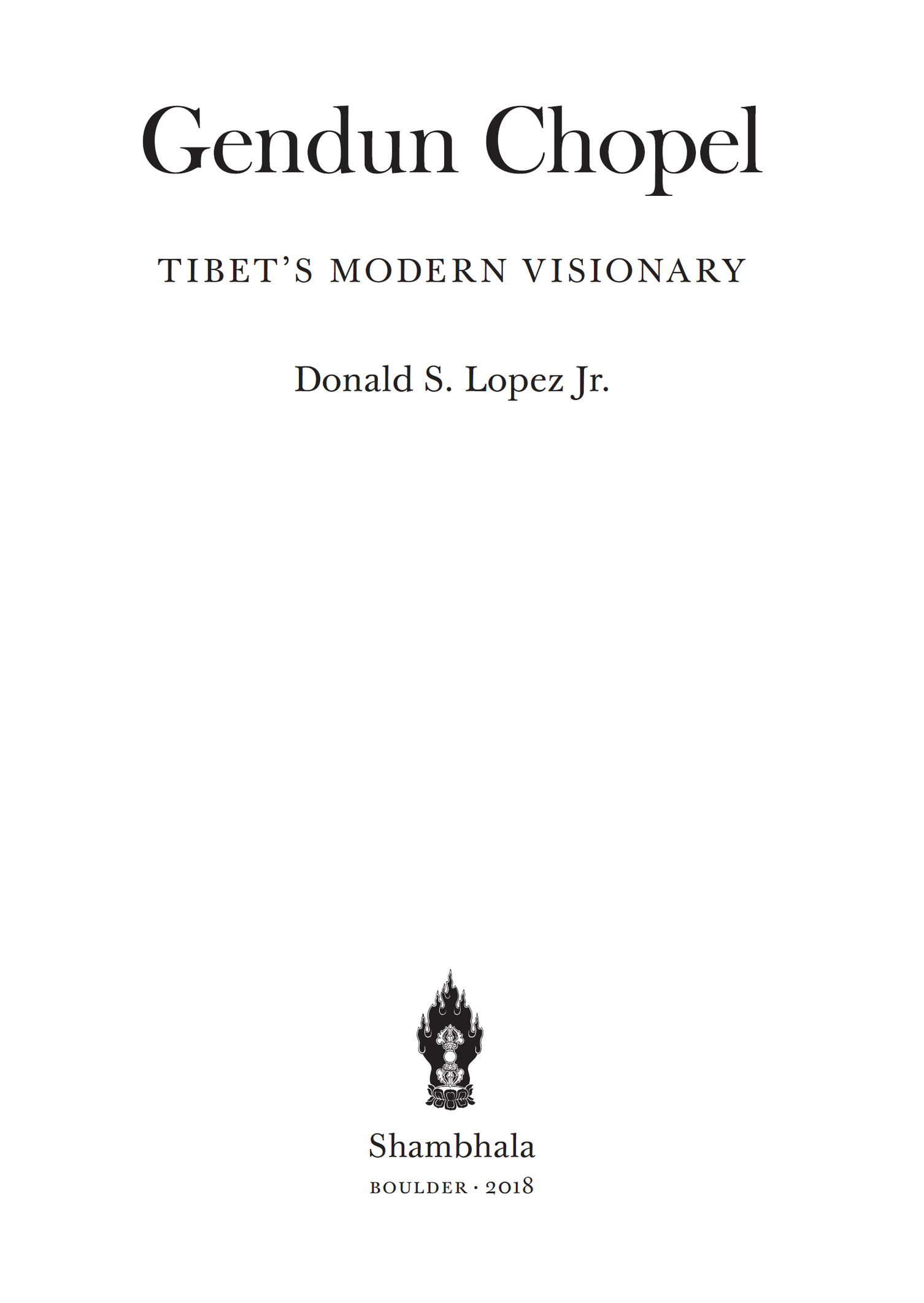Contents
LIVES OF THE MASTERS
Shambhala Publications, Inc.
4720 Walnut Street, Boulder, Colorado 80301
www.shambhala.com
2018 by Donald S. Lopez Jr.
FRONTISPIECE : A photo that Gendun Chopel sent to his mother after his arrival in India in 1934.
Excerpts from Grains of Gold: Tales of a Cosmopolitan Traveler, by Gendun Chopel, translated by Thupten Jinpa and Donald S. Lopez Jr., 2014 by The University of Chicago, all rights reserved; In the Forest of Faded Wisdom: 104 Poems by Gendun Chopel, a Bilingual Edition, edited and translated by Donald S. Lopez Jr., 2009 by The University of Chicago, all rights reserved; The Madmans Middle Way: Reflections on Reality of the Tibetan Monk Gendun Chopel, by Donald S. Lopez Jr., 2006 by The University of Chicago, all rights reserved; and The Passion Book: A Tibetan Guide to Love and Sex, by Gendun Chopel, translated and with an afterword by Donald S. Lopez Jr. and Thupten Jinpa, 2018 by The University of Chicago, all rights reserved; reprinted with permission by special arrangement with the University of Chicago Press.
All rights reserved.
No part of this book may be reproduced in any form or by any means, electronic or mechanical, including photocopying, recording, or by any information storage and retrieval system, without permission in writing from the publisher.
Cover art: Robert Fenwick May, Jr.
Cover design: Gopa & Ted2, Inc.
LIBRARY OF CONGRESS CATALOGING - IN - PUBLICATION DATA
Names: Lopez, Donald S., Jr., 1952 author. |Dge-dun-chos-phel, A-mdo, 19031951.
Title: Gendun Chopel: Tibets modern visionary / Donald Lopez.
Description: Boulder, Colorado: Shambhala, 2018. | Series: Lives of the masters | Includes bibliographical references and index.
Identifiers: LCCN 2017029910 | ISBN 9781611804065 (paperback)
eISBN 9780834841345
Subjects: LCSH : Dge-dun-chos-phel, A-mdo, 19031951. | LamasChinaAmdo (Region)Biography. | ScholarsChinaAmdo (Region)Biography. | Amdo (China: Region)Biography. | BISAC : RELIGION / Buddhism / Tibetan. | BIOGRAPHY & AUTOBIOGRAPHY / Religious. | HISTORY / Asia / India & South Asia.
Classification: LCC BQ950 . G38 L67 2018 | DDC 294.3/923092 [B]dc23
LC record available at https://lccn.loc.gov/2017029910
v5.3.1
a
Contents
Series Introduction
B UDDHIST TRADITIONS are heir to some of the most creative thinkers in world history. The Lives of the Masters series offers lively and reliable introductions to the lives, works, and legacies of key Buddhist teachers, philosophers, contemplatives, and writers. Each volume in the Lives series tells the story of an innovator who embodied the ideals of Buddhism, crafted a dynamic living tradition during his or her lifetime, and bequeathed a vibrant legacy of knowledge and practice to future generations.
Lives books rely on primary sources in the original languages to describe the extraordinary achievements of Buddhist thinkers and illuminate these achievements by vividly setting them within their historical contexts. Each volume offers a concise yet comprehensive summary of the masters life and an account of how they came to hold a central place in Buddhist traditions. Each contribution also contains a broad selection of the masters writings.
This series makes it possible for all readers to imagine Buddhist masters as deeply creative and inspired people whose work was animated by the rich complexity of their time and place and how these inspiring figures continue to engage our quest for knowledge and understanding today.
Kurtis Schaeffer, series editor
Preface
T HIS IS my sixth book about Gendun Chopel. I had not intended to write so much about him. I began with his controversial treatise on Madhyamaka, Adornment for Ngrjunas Thought, a work generally disavowed and despised by Gelukpas and embraced and beloved by Nyingmapas. I decided to translate this difficult texta text that others had begun but never finishedin the hope of bidding a fitting farewell to the Geluk scholasticism in which I had been trained at the University of Virginia in the 1970s. I was using the first edition of his collected works, published only in 1990, in three volumes, not in India, but in Lhasa. As I was leafing through volume 2 each day to get to the text, I would come across poems and stories that often seemed more interesting than the philosophical fine points of the affirming negative I published the poems with Tibetan and English on facing pages in a book called In the Forest of Faded Wisdom.
The more of Gendun Chopels works I read, the more I wanted to translate; with each reading I understood how misunderstood Gendun Chopel has been for so long. Much of what you hear about Gendun Chopel when speaking to Tibetans are stories: about the time at Gomang when he dressed up like an illiterate dop-dop, the monastic equivalent of the Hells Angels, and defeated a gesh on the debating courtyard; about the time he got dead drunk, took off all of his clothes, and then drew an elaborate and beautiful figure without lifting the pencil from the paper; about the time he put his cigarette out on the forehead of a Buddha image and then debated with some monks about whether the Buddha feels pain; about the time he laughed in the face of a powerful Tibetan aristocrat who praised Gendun Chopels translation of the Pli classic, the Dhammapada, as a blessed tantra of the Buddha. As entertaining as these anecdotes are, they are only that.
My point, and it is certainly a banal point, is that one learns a great deal about an author by actually reading what they wrote. To do that, we need to translate the authors works. However, this is more easily said than done with authors like Gendun Chopel, who wrote so much. And it is clear that he wanted to be remembered for his writings. In fact, he thought that that was all he would be remembered for. As he wrote in a poem:
In my youth, I did not take a delightful bride;
In old age, I did not amass the needed wealth.
That the life of this beggar ends with his pen,
This is what makes me feel so sad.
If I was to do justice to Gendun Chopel, if I was to have the courage of my convictions, I could not just translate his contested work on Madhyamaka, much of which was constructed from a students notes after he died. I could not just translate his poetry. I would have to translate the work that he considered his greatest contribution to Tibetan letters, a work that is over six hundred pages long. This is his Gtam rgyud gser gyi thang ma; even its title is hard to translate. When Gendun Chopels works are discussed, one often sees this book referred to as his travel journals. But this is because so few have read it; scholarship has focused almost exclusively on the first chapter and its list of Sanskrit manuscripts that Gendun Chopel and the Indian scholar Rahul Sankrityayan had discovered during expeditions in southern Tibet in 1934 and 1938. The distinguished Tibetan scholar Thupten Jinpa expressed interest in doing a co-translation of this work, something neither of us had tried before. The result was a fat book called Grains of Gold: Tales of a Cosmopolitan Traveler.


